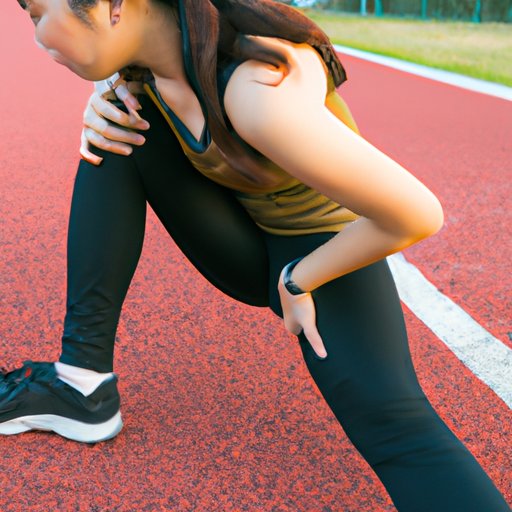Introduction
Cramps are a common symptom of many medical conditions, including PMS, endometriosis, and other menstrual issues. While there is no one-size-fits-all solution to dealing with cramps, there are a number of natural remedies and lifestyle changes that can help relieve the discomfort associated with them. One of these remedies is exercise.
Exercising during cramps can be beneficial in a number of ways, from improving circulation to reducing tension and stress. In this article, we will explore how exercise can help reduce cramping and provide some tips on how to use it for cramp relief during your period.

Exploring the Benefits of Exercise for Reducing Cramps
Exercise has a number of benefits when it comes to reducing cramps. It can improve circulation, reduce tension and stress, and increase endorphins, which can help reduce pain.
Improved circulation: When you exercise, your blood flow increases, allowing more oxygen and nutrients to reach your muscles and organs. This improved circulation can help reduce cramps by providing your body with the nutrients it needs to fight off inflammation and pain.
Reduced tension and stress: Exercise can help reduce tension and stress, both of which can contribute to cramping. Regular exercise helps to release endorphins, which are chemicals in the brain that act as natural painkillers. Endorphins can help reduce the intensity of cramps and make them easier to manage.
Increased endorphins: Endorphins also help to reduce stress levels. Stress can worsen cramps and make them more difficult to deal with. By increasing endorphin levels, exercise can help reduce stress and make cramps more manageable.
How Exercise Can Relieve Menstrual Cramps
Certain types of exercises can be particularly effective at relieving menstrual cramps. Low-impact activities such as walking or swimming can help reduce tension and stress without putting too much strain on the body. Yoga poses, such as Child’s Pose and Cat-Cow, can help stretch and relax tense muscles, while breathing exercises can help reduce stress levels.
Examples: Walking, swimming, yoga poses such as Child’s Pose and Cat-Cow, and breathing exercises.
A Look at How Physical Activity Can Help Reduce Cramping
Aerobic exercise: Aerobic exercise, such as running, cycling, or swimming, can help improve circulation and reduce tension. Regular aerobic exercise can also help to strengthen the abdominal muscles, which can help reduce cramping.
Strength training: Strength training can help to improve muscle tone, which can reduce cramping. Strengthening the abdominal muscles can also help to reduce the intensity of cramps.
Stretching: Stretching can help to relax the muscles and reduce tension. Stretching the abdominal muscles can help to reduce cramping.

Exercises to Ease Menstrual Cramps
Low-impact activities: Low-impact activities such as walking, swimming, or biking can help to reduce tension and stress without putting too much strain on the body. These activities can also help to improve circulation and reduce cramping.
Yoga poses: Certain yoga poses can help to stretch and relax the muscles, which can help reduce cramping. Examples of poses that can help ease menstrual cramps include Child’s Pose, Cat-Cow, and Cobra.
Breathing exercises: Breathing exercises can help to reduce stress and tension, which can help reduce cramping. Examples of breathing exercises include deep breathing, mindful breathing, and belly breathing.

The Science Behind Exercise and Cramp Relief
Hormone balance: Regular exercise can help to maintain hormone balance, which can help reduce cramping. Hormones such as estrogen and progesterone can affect the intensity of cramps, so maintaining a healthy balance of these hormones can help reduce cramping.
Increase in muscle tone: Regular exercise can help to improve muscle tone, which can reduce cramping. Stronger muscles can help reduce the intensity of cramps.
Relaxation of muscles: Exercise can help to relax the muscles, which can reduce cramping. Stretching and low-impact activities can help to relax the muscles and reduce tension.
How to Use Exercise to Combat Cramps During Your Period
Timing of exercise: Exercising during your period can help to reduce cramping. It is best to avoid strenuous activities, such as running or weight lifting, and focus on exercises that are low-impact and relaxing, such as walking or yoga.
Frequency: It is best to exercise regularly during your period. Try to do at least 30 minutes of exercise a day, but if you are feeling particularly uncomfortable, try to take frequent breaks throughout the day.
Types of exercises: Different types of exercises can be used to reduce cramping. Low-impact activities such as walking or swimming can help to reduce tension, while yoga poses and breathing exercises can help to relax the muscles and reduce stress.
Conclusion
Exercise can have a number of benefits when it comes to reducing cramps. From improved circulation to increased endorphins and hormone balance, exercise can help to reduce cramping and provide relief from menstrual pain. There are a number of different types of exercises that can be used to ease menstrual cramps, from low-impact activities to yoga poses and breathing exercises. By timing your exercise correctly, you can maximize its effectiveness and enjoy the benefits of cramp relief.
(Note: Is this article not meeting your expectations? Do you have knowledge or insights to share? Unlock new opportunities and expand your reach by joining our authors team. Click Registration to join us and share your expertise with our readers.)
